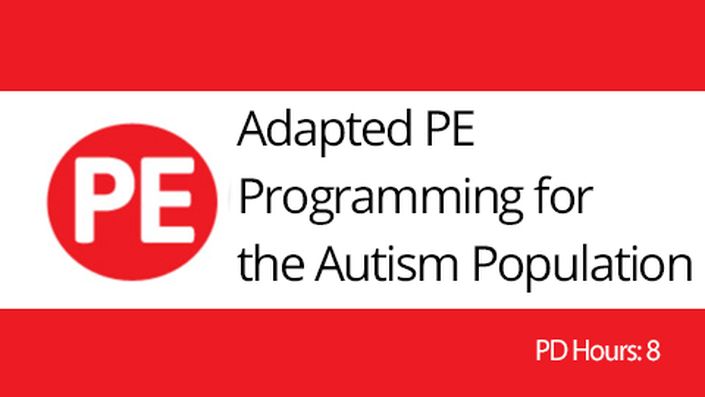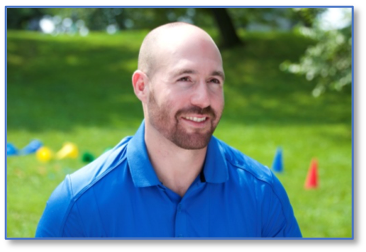
Adapted PE Programming for the Autism Population
Learn How to Effectively Teach Children with Autism in Physical Education
Watch PromoTestimonials
I really love all the videos from the instructor but also the students. I am a visual learner so this really helps. I had never heard of sand bells and am very interested in getting some and implementing these exercises. Thanks! - Annette C.
It was a very well laid out class with valid and practical/implementable points! Terrific job Eric! I learned a great deal! - Sherri O.
This course will take approximately 8 hours to complete. If you have any questions about the course, please email us at CE@hkusa.com.

Target Audience
This course has been designed for general and adapted physical education teachers working with ages 5-18. As the core content focuses on scalable program variables, all aspects of programming can be modified to meet the needs of students at any age or ability level.
Course Purpose/Objectives
The purpose of the course is to provide a contingency-based model for developing and implementing appropriate, effective fitness programs with the autism population in 1-to-1 and group/class settings. The course provides protocols for assessing physical, adaptive, and cognitive abilities as they relate to physical activities.
Course Objectives
- To understand the importance of physical fitness and Adapted PE for the ASD population
- To understand and identify common gross motor deficits
- To understand adaptive/behavioral complications and their impact on enganging in fitness activities
- To address cognitive deficits including receptive language skills
- To gain a working knowledge of the convergence and distinctions between Physical, Adaptive, and Cognitive Functioning
- To gain a working knowledge of appropriate and effective warm-up/mobility exercises
- To gain a working knowledge of appropriate and effective dynamic movement exercises
- To gain a working knowledge of appropriate and effective strength/stability exercises
- To understand appropriate progressions and regressions of exercises in each area of programming
- To account for individual differences (physical, adaptive, cognitive) within class environments
- To understand basic principles of program development for groups/classes
Course Description
There are often barriers to implementing fitness and adapted PE programs for the autism population. In order to do so successfully, instructors must understand and appreciate physical, adaptive, and cognitive functioning as they relate to movement activities.
This course addresses the specific considerations for each area of ability and provides strategies for designing and implementing programs for groups/classes. Not only does this course address how to structure an adapted PE class for students with ASD, but strategies to enhance physical performance, on-task behavior, and contingency-based learning.
Reading Materials
All reading materials are available to download in the form of PDF files from within the course module.
Viewing Materials
All videos will be available to download/view from within the course module. Some of the videos available to view are:
- Course Introduction
- Understanding the PAC Profile™
- Common Physical Deficits among the ASD Population
- The importance of Scaling: Progressions and Regressions
- Effective Exercise Selection: Warm-up/Mobility
- Effective Exercise Selection: Dynamic Movement
- Effective Exercise Selection: Strength/Stability
- Effective Exercise Selection: Games and Preferred Activities
- Considerations for Positive Behavior Support
- Assessing Physical Ability in Group Settings
- Programming the Warm-up/Mobility Phase
- Programming the Strength/Focus Phase
- Programming the Games/Preferred Activity Phase
- Positive Behavior Support in Group Settings
- Putting the Concepts and Practices Together: Conclusion
Course Design/Schedule
This course is designed in a way to present each area of ability (physical, adaptive, cognitive) as a necessary consideration and component of programming. As students progress through the course, they will gain an understanding of the interplay between these factors. By the end of the course, students should be able to select appropriate progressions and regressions of each exercise, and develop an individual or group program using the flow chart process.
Your Instructor

Eric Chessen, M.S. is the Founder of Autism Fitness. An Exercise Physiologist with an extensive background in Applied Behavior Analysis (ABA), Eric has spent nearly 20 years developing successful fitness and adapted PE programs. Eric is the creator of the PAC Profile Assessment and Method along with the Autism Fitness Certification. He resides in Charlotte, NC (by way of New York) where he works with his 1-to-1 athletes. Eric offers consulting and staff training worldwide. Visit AutismFitness.com to become and Autism Fitness Certified Pro.
Course Curriculum
-
StartAssignment 1: Introduction to the Course Video (1:48)
-
StartAssignment 2: Understanding Physical, Adaptive, and Cognitive Functioning (8:30)
-
StartAssignment 3: Common Physical Deficits in ASD (7:13)
-
StartAssignment 4: Scaling: Progressions and Regressions (1:47)
-
StartAssignment 5: Effective Exercise Selection: Warm-up/Mobility (25:26)
-
StartAssignment 6: Effective Exercise Selection: Dynamic Movement (19:08)
-
StartAssignment 7: Effective Exercise Selection: Strength/Stability (20:48)
-
StartAssignment 8: Effective Exercise Selection: Games and Preferred Activities (7:55)
-
StartAssignment 9: Considerations for Positive Behavior Support (7:03)
-
StartAssignment 10: Assessing Physical Ability in Group Settings (6:17)
-
StartAssignment 11:Programming the Warm-up/Mobility Phase
-
StartAssignment 12: Programming the Dynamic Movement Phase
-
StartAssignment 13: Programming the Strength/Focus Phase
-
StartAssignment 14: Programming the Games/Preferred Activity Phase (8:39)
-
StartAssignment 15: Positive Behavior Support in Group Settings (7:56)
-
StartAssignment 16: Putting the Concepts and Practices Together: Conclusion (8:12)
Check out Frequently Asked Questions Here!
